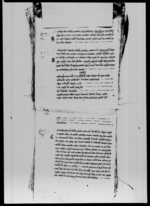A copy of a lālamohara from King Rājendra appointing Bhīmasena Mājhī and Punai Jaisī to manage the Dasaĩ worship of Śrī Mahākālī at Arghākoṭa (VS 1890)
ID: K_0003_0036C
Edited and
translated by Astrid Zotter
in collaboration with
Pabitra Bajracharya
Created: 2022-05-23;
Last modified: 2023-01-23
For the metadata of the document, click here
The accompanying edition, translation/synopsis and/or commentary are available under the terms of the Creative Commons Attribution-ShareAlike 4.0 International License
Abstract
The lālamohara from King Rājendra of which this is a copy appoints Bhīmasena Mājhi and Punai Jaisī to follow Hutadhvaja Sāhī in managing the rituals for Śrī Mahākālī of Arghākoṭa during both Dasaĩ festivals, with revenue from landed property during Baḍā Dasaĩ and with material supplied by the local administrator (āmālī) during Caite Dasaĩ.Diplomatic edition
[1r]
1⟪2⟪रुजु⟫1आगेभीमसेनमाझीपुनैजैसीके∙अर्घाकाअम्वल∙मध्ये∙मौलावोटोषेत∙२कोकुत∙धानमुरी∙
2६५घ्यूषानि∙रूपैञा∙५ले∙वडाडसैर∙अमालीवाट∙आय़ाका∙सर्रजामले∙चैत्यादसैमा∙अर्घाको∙
3ट∙श्रीमाहाकालि∙देविका∙नीत्य∙नैमीत्य∙पाठपुजावलि∙विधानगरी∙हाम्रोजये़मनाऊनुभ∙
4नि∙अघीहुतध्वज∙साहीकानाऊमा∙मोहरगरीवक्स्याकोहो∙रांगावोकाको∙मोलपनि∙वेलामा∙
5पाऊदैनौ∙ऊनिवाटटहलपनि∙पुगदैन∙भनिअर्घाका∙थनि∙भला∙आदमी∙हरुआई∙श्रीज∙
6नरल∙भीमसेन∙थापाछेऊविस्तारगर्या∙छन∙र∙सोविस्तार∙श्रीजनरल∙वाटहाम्राहजुरजाहेर∙
7भय़ो∙तसर्थ∙हुत∙ध्वज∙साही∙कानाऊका∙मोहरहानि∙अघी∙देषि∙चलिआय़ा∙वमोजी∙मौ∙
8लावोट∙षेत्∙२कावदनि∙घ्यूषानिले∙वडाडसैगर्नु∙अमालीवाट∙आऊन्या∙सरजामले∙चैत्या∙
9दसै∙गर्नु∙रागा∙वोका∙पुजाको∙सरजाम∙रैती∙वाट∙लीय़ाका∙मालकोमोल∙षसोषास∙चु∙
10क्तीगरी∙दीनु∙आफ्नाआत∙का∙वलले∙जिऊ∙धर∙माझीले∙विर्हाय़ाका∙कुमाल∙टारी∙लाईद∙
11रीय़ाकोटेक∙रुपैय़ा∙२२॥सालींन्दा¯ ¯ ¯पलटनका∙दफडरषाना∙मावुझाई∙मौलामा∙डसै∙
12गर्न्या∙लेषेत्∙को∙चलन∙गर्नु∙भनि∙वंधेज∙वाधी∙वक्स्यौं∙आफ्ना∙षातिर∙जामा∙संग∙वि∙
13धीपुर्वक∙पाठपुजा∙वलि∙विधान∙गरी∙हाम्रो∙जये़∙मनाई∙षोला∙काथरी∙भला∙आदमी
14सवै∙सामीलभै∙सालवसाल∙डसै∙गर्न्या∙कामगरईति∙मीतीसडर∙¯ ¯¯¯ ¯¯¯¯¯¯
Translation
[1r]
se naṃ 5951
attested (ruju)
Āge: To Bhīmasena Mājhī and Punai Jaisī
Earlier a mohara was issued in the name of Hutadhvaja Sāhī stating: "Arrange for the regular and occasional recitation, worship and sacrifice for Śrī Mahākālī Devī (text: māhākāli devi) [at] Arghākoṭa, during the Baḍā Dasaĩ festival with the kuta revenue from [land measuring] 2 khetas [at] Maulāboṭo within the administrative unit (ambala) of Arghā—[comprising] 65 murīs of paddy [and] a ghiu khāne levy of 5 rupees—and during the Caite Dasaĩ festival with accessories (sarjāma) supplied by the local administrator (amālī); and celebrate our triumphs." It appears that the village headmen (thani for thānī) and local notables (bhalādamī) of Arghā came and reported to Śrī General Bhīmasena Thāpā: "We do neither receive the price for the he-buffaloes and he-goats in time, nor is the service he (i.e. Hutadhvaja Sāhī) provides sufficient." And this report was brought to our notice by the venerable general. Therefore we annul the mohara in Hutadhvaja Sāhī's name and fix the following regulation (bandeja): Perform the Baḍā Dasaĩ in accordance with what has traditionally been practised before with the produce (?)2 of the 2 khetas [of land] at Maulāboṭa [and] the ghiu khāne levy [on it]. Perform the Caite Dasaĩ with the accessories that come from the amālī. Pay without evasion the prices for the he-buffaloes, he-goats, accessories for worship and [other] material taken from the ryots. Submit annually the 22 rupees specified by contract (ṭheka) for the rainfed paddy (ṭārī) of the Kumāles—newly cultivated by Jiūdhara Mājhī with his own hands (āta for hāta?)—to the Daphadarakhānā of the [Sabuja]3 Palṭana and keep a written account (lekhet for lekhoṭa or likhat?) of [the performance of] Dasaĩ [with blood sacrifices] at the sacrificial post (maulo).4 Being conscious of your duties, arrange the recitation, worship and blood sacrifices according to the rule, celebrate our triumphs and carry out the task of performing the Dasaĩ [rituals] every year in consensus with all clan elders (tharī) of the river (?)5 and [all] local notables (bhalā ādamī).
The date is confirmed.6
Commentary
The document puts two persons, Bhīmasena Mājhī and Punai Jaisī, in charge of organizing the Dasaĩ rituals at Arghākoṭa, as the previous manager had failed to perform his task properly and the local people had complained about his misconduct.
The document quotes the previous appointment of Hutadhvaja Sāhī to the post. Such an appointment, issued in VS 1877 (1820 CE), is extant in the form of a copy (K_0020_0031B). That document, however, does not contain the details quoted in the present document, but only appoints Hutadhvaja to take up from the previous holder of the post. So there possibly was another document specifying Hutadhvaja's duties. A follow-up document to the present lālamohara is also extant in copy form (K_0017_0001B). It appoints Bhīmasena Mājhī to carry out the duties around Dasaĩ at Arghā alone, as Punai Jaisī had quarrelled and the rituals had therefore not been carried out properly.
For more on related documents and the conflicts over the observance of Dasaĩ at Arghā, see K_0031_0019C.

